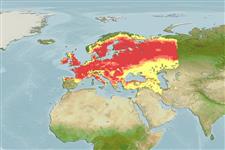Classificação / Names
Common names from other countries
Referência principal
Tamanho / Peso / Idade
Max length : 50.2 cm TL macho/indeterminado; (Ref. 88166); common length : 25.0 cm TL macho/indeterminado; (Ref. 556); Peso máx. publicado: 1.8 kg (Ref. 4699); Idade máx. registada: 14 anos (Ref. 41616)
Length at first maturity
Lm 14.0 range ? - ? cm
Ambiente
; Água doce; estuarina bentopelágico; pH range: 7.0 - 7.5; dH range: 10 - 15; potamódromo (Ref. 51243); intervalo de profundidade 15 - ? m
Clima / Intervalo
Subtropical; 10°C - 20°C (Ref. 1672), preferred ?; 71°N - 36°N, 10°W - 155°E
Distribuição
Europe: north to Pyrenees and Alps, eastward to Ural and Eya drainages (Caspian basin); Aegean basin in Pinios, Vardar, Vegoritis, Kastoria, Struma and Maritza drainages. Asia: Marmara basin and lower Sakarya in Anatolia, Aral basin, and Siberia from Ob eastward to Lena drainages. Naturally absent from Iberian Peninsula, Adriatic basin, Italy, Great Britain north of 56 N, Scandinavia north of 69° N. Locally introduced in Spain; introduced and invasive in northeastern Italy. At least one country reports adverse ecological impact after introduction.
Países | Áreas FAO | Ecossistemas | Ocorrências | Introduções
Descrição breve
Espinhos dorsais (total): 3; Raios dorsais moles (total): 9-12; Espinhos anais 3; Raios anais moles: 9 - 13; Vértebras: 39 - 41. The only species of the genus in Atlantic basin north of Pyrénées which can be distinguished from its congeners in Black and Caspian Sea basins and Apennine Peninsula by the combination of the following characters: 39-41 + 2-3 (41-44 total) scales along lateral line; dorsal and anal fins with 10½ branched rays; body laterally compressed, depth 25-35% SL; mouth terminal; snout pointed; iris from yellow in juveniles to deep red in adults; pectoral, pelvic and anal fins orange to red; and no midlateral stripe. Differs from its congeners in Balkan Peninsula by uniquely possessing 10½ branched anal rays (Ref. 59043). Caudal fin with 18-19 rays (Ref. 2196). Also Ref. 96829.
Categoria na Lista Vermelha da IUCN (Ref. 115185)
Ameaça para o homem
Potential pest (Ref. 59043)
Utilização humana
Pescarias: espécies comerciais; Aquacultura: espécies comerciais; peixe desportivo: sim
Ferramentas
Relatórios especiais
Descarregue XML
Fontes da internet
Estimates of some properties based on models
Phylogenetic diversity index
PD50 = 0.5020 many relatives (e.g. carps) 0.5 - 2.0 few relatives (e.g. lungfishes)
Nível Trófico
3.0 ±0.0 se; Based on diet studies.
Resiliência
Médio, tempo mínimo de duplicação da população 1,4 - 4,4 anos (K=0.10-0.21; tm=2-3; tmax=12)
Vulnerabilidade
Moderate to high vulnerability (53 of 100)
Categoria de preço
